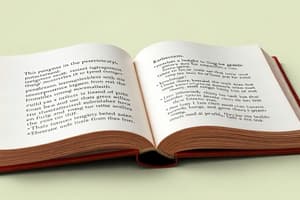Podcast
Questions and Answers
What does the term 'figurative language' refer to?
What does the term 'figurative language' refer to?
- A type of humor in literature
- Using symbols, figures, or likenesses to express ideas (correct)
- The use of literal meanings in writing
- Expressing ideas in a straightforward manner
Which figure of speech is exemplified in the statement 'Life is a rollercoaster'?
Which figure of speech is exemplified in the statement 'Life is a rollercoaster'?
- Simile
- Metaphor (correct)
- Personification
- Hyperbole
What does personification do in figurative language?
What does personification do in figurative language?
- Compares two unlike objects
- Creates irony in expressions
- Gives human qualities to non-human elements (correct)
- Makes exaggerated statements
In the statement 'She has a million things to do today', what type of figurative language is used?
In the statement 'She has a million things to do today', what type of figurative language is used?
What does the figure of speech irony convey?
What does the figure of speech irony convey?
What is the purpose of using similes in writing?
What is the purpose of using similes in writing?
Which of the following examples illustrates hyperbole?
Which of the following examples illustrates hyperbole?
Why is it important to learn about different types of figurative language?
Why is it important to learn about different types of figurative language?
What is the definition of onomatopoeia?
What is the definition of onomatopoeia?
Which sound device is demonstrated in the phrase 'Fine, Fun, Fab Friday, Folks!'?
Which sound device is demonstrated in the phrase 'Fine, Fun, Fab Friday, Folks!'?
What is assonance?
What is assonance?
How do poets use sound devices?
How do poets use sound devices?
Which of the following is an example of alliteration?
Which of the following is an example of alliteration?
Which example best illustrates onomatopoeia?
Which example best illustrates onomatopoeia?
What aspect of learning is emphasized as an essential performance outcome?
What aspect of learning is emphasized as an essential performance outcome?
In which of the following sentences is assonance used?
In which of the following sentences is assonance used?
Flashcards
Figurative Language
Figurative Language
A way to express ideas using symbols, figures, or comparisons instead of literal language.
Simile
Simile
A comparison of two unlike things using "like" or "as".
Metaphor
Metaphor
A direct comparison of two unlike things without using "like" or "as".
Personification
Personification
Signup and view all the flashcards
Hyperbole
Hyperbole
Signup and view all the flashcards
Irony
Irony
Signup and view all the flashcards
Example of Simile
Example of Simile
Signup and view all the flashcards
Example of Metaphor
Example of Metaphor
Signup and view all the flashcards
Sound Devices
Sound Devices
Signup and view all the flashcards
Onomatopoeia
Onomatopoeia
Signup and view all the flashcards
Alliteration
Alliteration
Signup and view all the flashcards
Assonance
Assonance
Signup and view all the flashcards
What are the three main sound devices?
What are the three main sound devices?
Signup and view all the flashcards
Example of Onomatopoeia
Example of Onomatopoeia
Signup and view all the flashcards
Example of Alliteration
Example of Alliteration
Signup and view all the flashcards
Example of Assonance
Example of Assonance
Signup and view all the flashcards
Study Notes
Grade 6 Life Performance Outcomes
- Students are Christ-centered Paulinians.
- They are mindful, self-directed learners.
- They are role models, consciously expressing their faith.
Essential Performance Outcome (EPO10)
- Students describe and explain new abilities from self-initiated learning experiences and projects.
Intended Learning Outcomes
- Identify figures of speech.
- Create statements containing figures of speech.
Figurative Language
- A way to express ideas using symbols, figures, or likenesses.
- Opposite of literal language; doesn't directly state ideas.
Simile
- A comparison of two unlike objects using "like" or "as".
- Example: "She is as busy as a bee!"
Metaphor
- A direct comparison of two unlike objects without using "like" or "as".
- Example: "Life is a rollercoaster."
Personification
- A figure of speech giving human qualities to places, objects, animals, or ideas.
- Example: "The trees are dancing."
Hyperbole
- A figure of speech using overstatement or exaggeration.
- Example: "I can cry a river!"
Irony
- A figure of speech expressing the opposite of what's expected.
- Example: Saying "What a beautiful day!" when it's raining.
Activity (Try It)
- Students will identify figures of speech in provided examples.
- Examples include:
- My heart is a drum, beating out a rhythm of longing.
- She has a million things to do today.
- Her eyes were as blue as the ocean.
- The moon whispered secrets to the night sky.
- It's a beautiful day for a picnic, and it's pouring rain.
Further Questions
- Why is it important to understand figurative language?
- How does learning about figurative language help readers and writers?
Studying That Suits You
Use AI to generate personalized quizzes and flashcards to suit your learning preferences.




